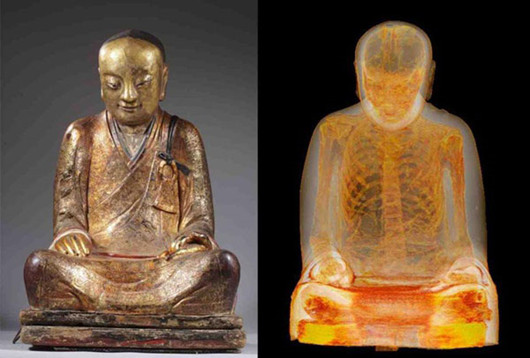
. > WHAT'S NEW > PHOTO
Dutch collector: Mummified Buddha will return to China
Author : Source : China Daily 2015-05-09

A CT scan showed a body, with the internal organs removed, concealed in an ancient Chinese statue of a Buddha. [Photos provided by the Drents Museum]
Through a social network, Dutch private collector Oscar van Overeem, who owns the 1,000-year-old Buddha statue with a mummified monk inside, said recently he is willing to return the relic to China.
According to The New York Times, van Overeem, an architect, last month publicly acknowledged for the first time on the networking site LinkedIn that he owned the mummified Buddha. He bought the statue for 40,000 Dutch guilders ($20,544) in 1996 from a collector in Amsterdam who had acquired it in Hong Kong.
Via LinkedIn, van Overeem said that he had reached a tentative agreement to donate the mummy to "a major Buddhist temple" near Yangchun village in the southeastern Chinese province of Fujian, where the statute was likely to be the personification of Patriarch Zhanggong, who practiced self-mummification in the village during the Song Dynasty (960-1279).
An unidentified foundation will offer him some compensation for what he has invested in the statue and in researching its history, he said.
Patriarch Zhanggong was a monk named Zhang Qisan who was known as a benevolent healer. He was worshiped as an ancestor by villagers in Yangchun village.
In Beijing News' interview via LinkedIn, van Overeem only said "I don't want to say a lot. There are negotiations on the way."
Van Overeem added that he was letting go of the statue because he believed it deserved to return to its homeland “to be incorporated in truly Buddhist surroundings” and worshiped “by those who love and appreciate him.”
The mummy's well-being may be the only issue on which van Overeem, as well as the villagers of Yangchun, agree.
Villagers in Yangchun village wrote letters in April to the Dutch museum and collector demanding the return of the Buddha statue, while the State Administration of Cultural Heritage in China paid closed attention on the affair.
On May 6, the head of the Cultural Relics Identification Center in Fujian Administration of Cultural Heritage said that the State Administration of Cultural Heritage had full authority over the mummified Buddha situation, but the provincial administration wanted to do more research on Yangchun village to get more information about the statue.
According to him, the provincial administration has been collecting evidence ever since March. By comparing photos and specifics on the size, height and weight of the Buddha that is currently owned by the Dutch collector and the one that went missing 19 years ago, it was initially confirmed that the two statues were identical.
In ancient China, monks who made great achievements usually practiced self-mummification when they felt they are about to die. They stopped eating and drinking to deplete their organs in the period until death.
After a monk died, he was buried sitting in the lotus position in a clay vessel. The preserved body was decorated with paint and adorned with gold.

A researcher studied a hole in the ear of a Buddha statue dated to the 11th or 12th century at the Drents Museum in the Netherlands. [Photos provided by the Drents Museum]
Ye Shengtao made Chinese fairy tales from a wilderness
Ye Shengtao (1894–1988) created the first collection of fairy tales in the history of Chinese children’s literature...
-
How northern ethnicities integrated into Chinese nation
2023-09-18
-
Mogao caves
2023-09-12
-
Mogao Grottoes as ‘a place of pilgrimage’
2023-09-12
-
Time-honored architectural traditions in China
2023-08-29
-
Disentangling the civilizational evolution of China
2023-08-28
-
AI ethics in science fiction
2023-08-23













 2011-2013 by www.cssn.cn. All Rights Reserved
2011-2013 by www.cssn.cn. All Rights Reserved